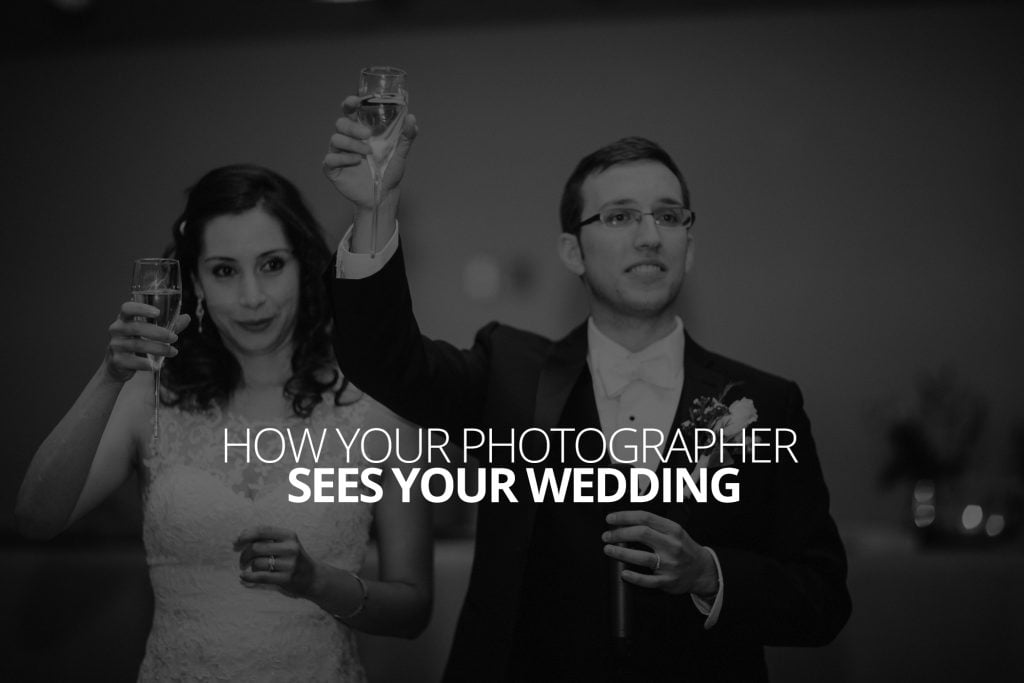When you envision your wedding, you probably think in terms of where you need to be, or what will be there, or what you need to do there. There’s the stylist in the morning, then makeup a little later, then there’s mimosas, then you need to take some photos, then you need to be on your way to get to the church on time, then there’s some more photos, followed by another mad dash to the reception hall where there might be even more photos, and then there’s toasts and dancing and a cake cutting.
Your photographer sees all these things too, but categorizes them for planning purposes very differently. When we see a wedding plan, the intricacies and details of the plan aren’t the first thing we see. Instead, the thing we usually notice first is the ‘Spectrum of Control’ that’s going to be available to us. See, while it may seem like the contents of your wedding day is what matters to the results of the photography, in most cases it’s actually the shape of the day that matters the most. When I say the ‘shape’ of a day, I’m not only talking about what will happen, but where, and how, and under what practical or etiquette-related restrictions.
A Spectrum of Control
When people start looking for wedding photographers they often want to dig through wedding details they don’t realize are largely irrelevant to what their photographer needs to know in order to give you their best. “Have you ever shot this venue?”, “It’s a lot of people, do you cover events this big?”. One could be forgiven for seeking answers to these kinds of questions—they seem like they would matter.
But, in actuality, a photographer who is adept with their equipment, clear in their vision, and rehearsed in their expectations, can walk into essentially any kind of ‘party’ or ‘event’, held pretty much anywhere, and create something worthwhile. It doesn’t matter very much whether they’ve been to that location before, or whether they have photographed something with this many guests before. Every venue comes with it’s own quirks, which a skilled photographer will identify and work around within minutes, and if they’ve worked with 50 guests, they’ve worked with 500. From our perspective, what matters most is that all of these sorts of shooting situations share approximately the same place on the Spectrum of Control—that is to say, very little control; We just have to pay attention and take the best pictures we can of whatever happens to be going on at the moment.
Anything that takes place on that end of the spectrum, for us, is going to be functionally similar to everything else. And, the same is generally true on the other end of the spectrum, too.
On the other end of the spectrum, we have things like family and wedding party formals; situations where not only do we have control, we actually have most of the control. We decide where we go, how long we spend in any one spot, where and how people stand, and depending on restrictions (which we’ll get to in a moment), what the lighting conditions look like. So, whether you wanted to take photos inside a dusty barn with your wedding party, or family photos out in an open field, or couple’s portraits out on a busy city sidewalk, these are all functionally similar from your photographers standpoint—they all allow us a great deal of control.
Besides those situations where we need to be a fly on the wall (Low control; a wedding ceremony, for example), and those situations where we’re almost totally in control (High control; wedding formals), there are near infinite stops along the spectrum in between. For example, a wedding reception falls somewhere in the middle, as we spend most of our time observing and creating images without any intervention, but occasionally direct a small group of people for an impromptu arrangement together.
How we interpret where we land on the Spectrum of Control depends on etiquette and expectations, as well as practical and technical restrictions.
Expectation & Etiquette Restrictions
People tend to have two kinds of restrictive expectations: Expectations about how the images will look, and expectations about how long it will take to create those images. Meanwhile, there’s typically only one restrictive kind of etiquette: the photographer should not draw too much attention to themselves. For many people, this often ends up being a kind of ‘pick two’ situation, because the kinds of images you’re expecting probably take longer to create than you think, and when photos take longer than expected, it pretty much always draws attention to the photographer.
Consider this—-if you’re expecting magazine style, polished wedding party formals, you need your photographer on the very high end of the Spectrum of Control during that process, which means removing as many restrictions as possible. So, in that case, you’re likely to have to make your guests wait, and thus accepting concessions in regards to wedding day timing etiquette. Or, in reverse, if you don’t want to make your guests wait and can’t compromise on that etiquette, then you’ll need to make concessions on how you expect the images to look, or else arrange to do the images at a time that won’t leave guests waiting (A “first look” for example, if you value the tradition, is another kind of concession that results in more control).
Similarly, a wedding ceremony is typically a situation where your photographer is very low on the Spectrum of Control. If there is a very particular image you want during the ceremony, and it’s difficult to take without the photographer drawing attention to themselves, you’ll have to break etiquette restrictions in order to give them the control they need.
Practical & Technical Restrictions
Practical & technical restrictions are mostly outside of anyone’s control in the moment, but not necessarily when planning. And that is why these become the last considerations in this discussion of where a photographer lands on the Spectrum of Control, and why it’s so important to understand how your plan is going to affect your photographer’s control.
If you have planned to give your photographer 30 minutes to take couples portraits outside your venue after the wedding ceremony, then you’ve placed your photographer quite high on the Spectrum of Control. The restrictions are the timeframe (30 minutes), and the lighting conditions outside (sunny, or hopefully lightly cloudy). That’s excellent, but if it happens to rain, then suddenly the photographer’s place on the Spectrum of Control has been dramatically changed. Although one aspect of your photographer’s control has gone up (they’ll need to light indoor photos now, and they can do that however they like), the restrictions have also gone way up. There’s less space to work with, and the time available is going to be starved because lighting a scene takes time.
Because of the unexpected practical restrictions, in the grand scheme of our goals at your wedding, we have lost a great deal of control over our outcomes, until you do a ‘pick two’ from our previous discussion of expectations and etiquette restrictions. Either change your expectations for the photos, or respond to etiquette differently.
A similar phenomenon can happen during a wedding reception where our control is typically quite low. If, for example, the lighting conditions in the room change mid-way through your reception (e.g., the lights dim just as dancing starts, or your DJ turns on a light show for the dance floor), we’re going to have to exercise greater control over our lighting, which can sometimes bump up against etiquette. If you don’t want camera flashes popping off during your reception, you’re going to have to do that pick-two dance again.
Why Any of This Matters
One of the great challenges of planning a wedding is understanding how to speak to your wedding vendors to get what you really want from your wedding day. With a photographer, that can be much easier said than done. Our task at a wedding is nebulous and covers many technical disciplines, which all come with their own practical considerations. A good photographer makes a plan to work between their vision and their restrictions, and understand how your plan bumps up against their ability to do what you’ve hired them to do, will not only make their job easier, but more predictable.
Photographer’s hate surprises at events as meaningful and important as a wedding day. That means surprises you plan for, as well as those you don’t. From a practical standpoint, we don’t much care that there is a surprise, we only care how it affects our control over our outcomes. The more you can help provide your photographer with the control they need, and clear expectations on when and how their control will be restricted, the better equipped they will be for the day, and the less likely they will be to miss your expectations.
Try to find a photographer who’s able to speak with you on this level. You shouldn’t have to know all of this, and they should help you sort all this out. But, avoid a photographer whose expression goes blank when you try to discuss control related considerations, it’s pretty good evidence that they lack meaningful experience, and are likely not ready to be out there shooting something as important as a wedding day.

